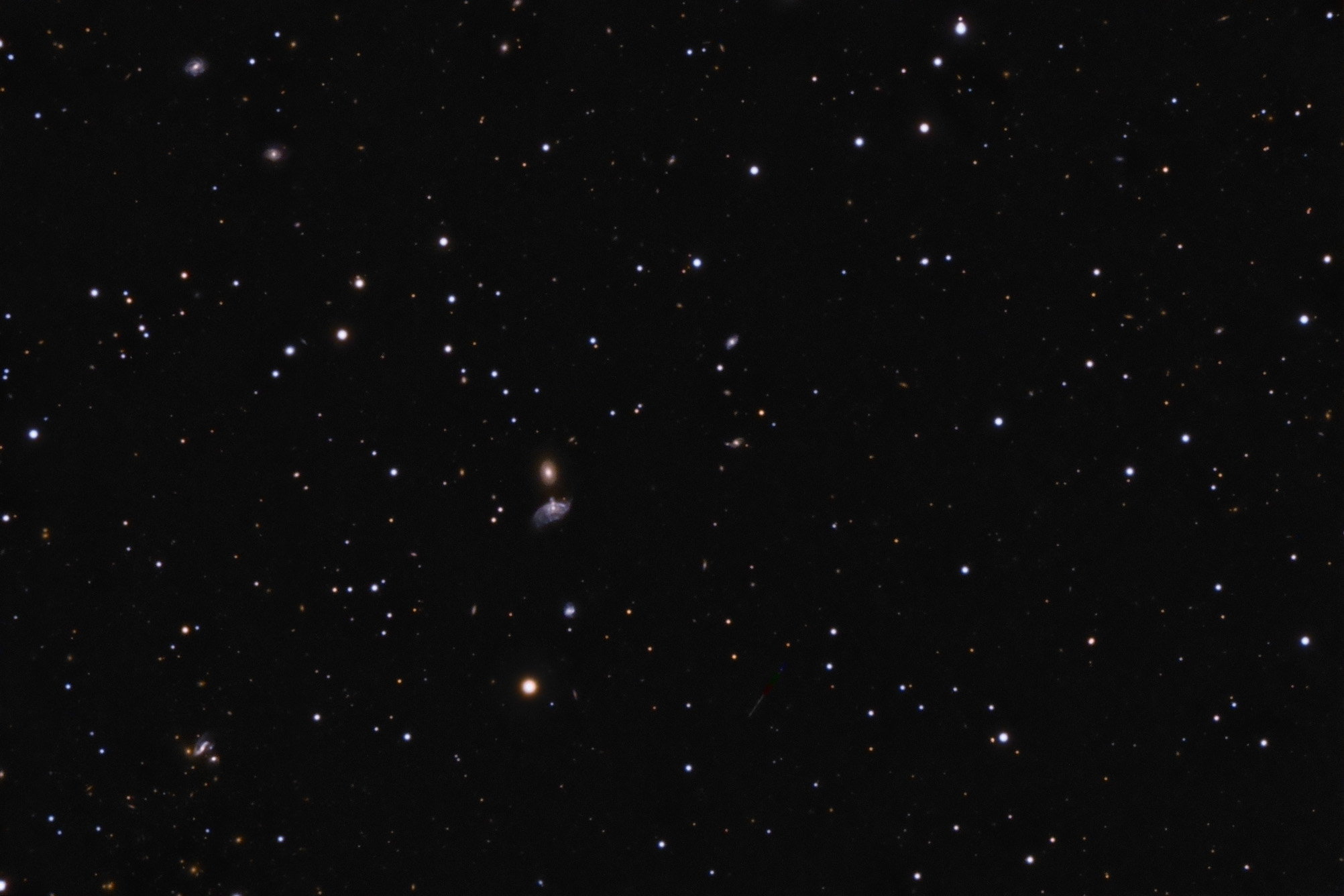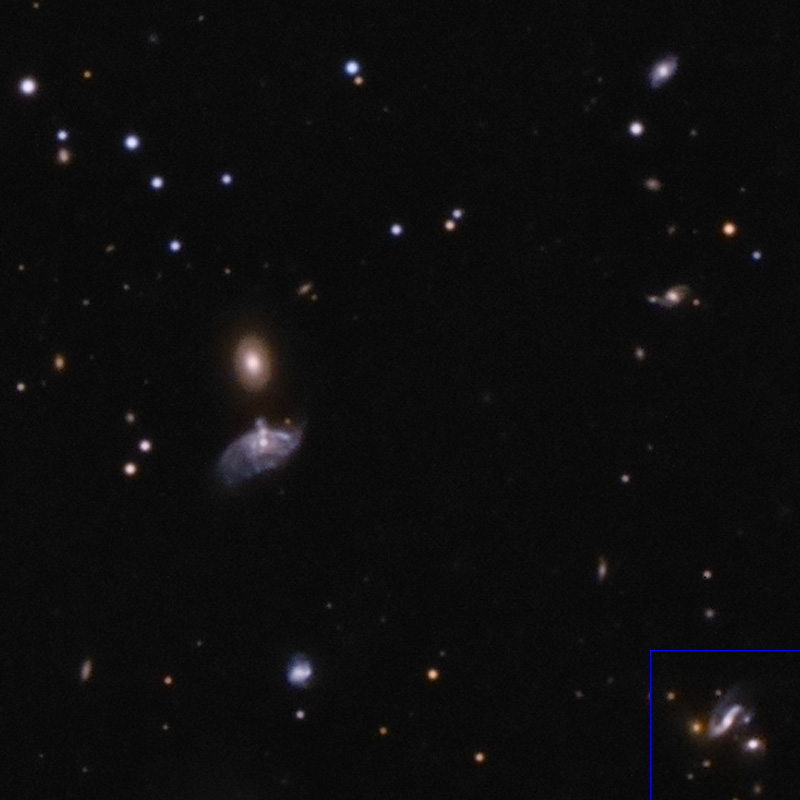Object name: ARP088Designation(s): ARP088, ARP119, ARP048, An Arp 3 fer in Pisces!
Arp 88 (Very small pair, in cropped image above center to the right)
This one falls in his category Spirals with large, high surface brightness companions on their arms. There is very little on this one. It is also known as PGC 004728/VV 445 and listed as a galaxy pair in the VV catalog as well as the Arp Atlas. The larger spiral carries the designation 2MASX J01190524+1228240 so is an IR source. NED gives no distance data nor attempts to even classify it as a spiral. Even its magnitude estimate is blank! I'm literally drawing a blank on this one. Even the note at NED is very strange. There's only the one. I guess when as a researcher you draw a blank this is what you write:
"One of the rare cases where the companion at the end of a spiral arm is also a spiral. Here, a chain of H II regions encircles the massive condensation thus forming a small spiral ripening at the periphery of the larger one and liable to gemmate." I really doubt it is reproducing by budding as his comment would seem to indicate! The note does date to 1977. Likely he is being descriptive in a more poetic way than Arp. http://adsabs.harvard.edu/cgi-bin/bib_query?1977A%26AS...28....1V
It's a 41 meg download, I didn't download it just trusted NED's note.
Arp 119 (The obvious pair)
Arp put it in his category of Elliptical and elliptical-like galaxies close to and perturbing spirals. The southern galaxy, MCG +02-04-021, is the more interesting. It shows two radial velocities with an emission knot between the core and northern galaxy showing a radial velocity about 800 km per second faster. NED classes it as SBc with an AGN while in another place it says Sdm: LINER. A note says SA(r)cd pec. I don't really see the ring many papers mention but otherwise, I agree with this last classification.
The northern galaxy is MCG +02-04-022. It is classed as E? This seems odd to me as well. A note at NED says: "Our images show a clear stretching of this galaxy along the direction towards Arp 119S. We observe two definite components: an inner region (a < 16") where the surface brightness profile seems of de Vaucouleurs type, and other external region (a > 18") where the {mu} profile looks like a exponential profile. However, the geometric profiles do not show evidence for disky structure. At this point, the galaxy could be classified as E3 ... The total ... color is representative of E, S0 types." That I can agree with. Its radial velocity is about half waybetween the two measurements for the southern galaxy. It does appear they are interacting.
Arp's comment on this pair reads "Some material seems attracted, some repelled." Using the northern galaxies radial velocity the distance to this pair is about 640 million light-years.
The Odd looking blue galaxy below Arp 119 is MRK 0983. It is classed simply as Peculiar though appears to be a distorted spiral. I wouldn't be surprised if it isn't actually two interacting galaxies but I have nothing to support this but what I see in my image. Its radial velocity puts it at about 630 million light-years. This likely means it is part of the Arp 119 system and may have tangled with one or both Arp 119 members.
Arp 48 (lower left corner if full image -- inset in cropped image)
The third Arp entry is Arp 48 to the southeast of Arp 119. Arp put it in his category: "Spiral Galaxies with low surface brightness companions on arms." I put it in the lower right corner of the enlarged and cropped image as there wasn't much in that corner but it is a bit confusing to put it there. When I imaged Arp 119 I knew Arp 88 was coming along for the ride but missed Arp 48. In fact, I imaged it separately a couple months later never realizing I already had it. Good thing as the intentional image had poor seeing compared to the Arp 119 image. It wasn't until I went to process this image I noted Arp 48 but thought it one Arp missed until I looked it up. The pair is also known as CGCG 436-026.
Individually the lower galaxy carries the IR source designation of 2MASX J01195923+1220377 and shows a radial velocity and shows a radial velocity distance of 635 million light-years. So it too is likely part of the same group as Arp 119. NED has no notes on it nor does it attempt to classify it. It does say this: "Low surface brightness companion on end of arm. M51 Type." Now, which of three objects is this referring to, the golden galaxy, the odd blue knot or galaxy by the cut-short arm or the galaxy to the south? I see no hint of an M51 type arm structure reaching over any of these. I could sort of make this work for the smaller blue fuzz patch, though that seems more likely a part of the northern galaxy's mostly missing arm.
The northern galaxy with one good and one not so good arm is another IR source listed as 2MASX J01200039+1220537 and also as PGC 4789. NED has absolutely nothing on it. Not even a magnitude. Odd, as it appears to be the major galaxy here. Arp certainly considered it the main one. It also appears that he considered the fainter blue fuzz patch as the companion on the arm and ignored the southern galaxy entirely. His comment reads: "Some material seems attached, some repelled." This "repelling" comment may be due to the sudden cut off of the arm. Without a redshift, it is impossible to say with certainty the northern galaxy is even related to either of the other two. I'd like some confirmation here. Neither the blue knot that's Arp's "companion" nor the golden galaxy just east of the northern spiral are in NED at all. This is a very poorly researched area it would appear.
There's an obvious galaxy cluster below Arp 48. This is NSCS J01195 at 4 billion light-years. NED shows it as containing 64 members. It extends south out of this field of view. While I got all of it in the later image of Arp 48 the seeing is so bad it isn't worth processing. This view will have to do.
The only other object in my image with a redshift measurement is CGCG 436-027. It is the blue spiral nearest the upper left corner. Oddly, NED makes no attempt to classify it, not even The only other object in my image with a red shift measurement is CGCG 436-027. It is the blue spiral nearest the upper left corner. Oddly, NED makes no attempt to classify it, not even a a spiral. It too appears to be about 635 million light-years away and thus part of the same system that Arp 119 and Arp 48 reside in. Though it appears very ordinary with nicely defined spiral arms. It too is listed as an IR source (2MASX J01200039+1238007). To its lower right is another rather obvious spiral that does appear to have a southern arm drawn well away from its "body". The gap seems oddly dark in fact. It is another IR source, 2MASX J01195236+1235486. I presume it too is part of the same system but can't confirm it without more data. It too may have some distortion.The only other object in my image with a red shift measurement is CGCG 436-027. It is the blue spiral nearest the upper left corner. Oddly, NED makes no attempt to classify it, not even a a spiral. It too appears to be about 635 million light-years away and thus part of the same system that Arp 119 and Arp 48 reside in. Though it appears very ordinary with nicely defined spiral arms. It too is listed as an IR source (2MASX J01200039+1238007). To its lower right is another rather obvious spiral that does appear to have a southern arm drawn well away from its "body". The gap seems oddly dark in fact. It is another IR source, 2MASX J01195236+1235486. I presume it too is part of the same system but can't confirm it without more data. It too may have some distortion.The only other object in my image with a red shift measurement is CGCG 436-027. It is the blue spiral nearest the upper left corner. Oddly, NED makes no attempt to classify it, not even a a spiral. It too appears to be about 635 million light-years away and thus part of the same system that Arp 119 and Arp 48 reside in. Though it appears very ordinary with nicely defined spiral arms. It too is listed as an IR source (2MASX J01200039+1238007). To its lower right is another rather obvious spiral that does appear to have a southern arm drawn well away from its "body". The gap seems oddly dark in fact. It is another IR source, 2MASX J01195236+1235486. I presume it too is part of the same system but can't confirm it without more data. It too may have some distortion.The only other object in my image with a redshift measurement is CGCG 436-027. It is the blue spiral nearest the upper left corner. Oddly, NED makes no attempt to classify it, not even a a spiral. It too appears to be about 635 million light-years away and thus part of the same system that Arp 119 and Arp 48 reside in. Though it appears very ordinary with nicely defined spiral arms. It too is listed as an IR source (2MASX J01200039+1238007). To its lower right is another rather obvious spiral that does appear to have a southern arm drawn well away from its "body". The gap seems oddly dark in fact. It is another IR source, 2MASX J01195236+1235486. I presume it too is part of the same system but can't confirm it without more data. It too may have some distortion.a spiral. It too appears to be about 635 million light-years away and thus part of the same system that Arp 119 and Arp 48 reside in. Though it appears very ordinary with nicely defined spiral arms. It too is listed as an IR source (2MASX J01200039+1238007). To its lower right is another rather obvious spiral that does appear to have a southern arm drawn well away from its "body". The gap seems oddly dark in fact. It is another IR source, 2MASX J01195236+1235486. I presume it too is part of the same system but can't confirm it without more data. It too may have some distortion.
The obvious asteroid in the image is (243847) 2000 VA62 at an estimated magnitude of 17.7. This magnitude seems reasonable.
A second asteroid in the image is more difficult to find. It is near the right edge a bit below center just above a typical white star. It shows as a horizontal line about 7 pixels long so is very short. It is the slow moving asteroid (146703) 2001 VY112 at an estimated magnitude of 19.5. It appears only slightly fainter than the far brighter (243847) 2000 VA62 because its very slow motion greatly increases its exposure time on any one pixel. As there isn't much information on this field the annotated image only points out the three Arp systems and the two asteroids.
Arp's image of #48
http://ned.ipac.caltech.edu/level5/Arp/Figures/big_arp48.jpeg
Arp's image of #88
http://ned.ipac.caltech.edu/level5/Arp/Figures/big_arp88.jpeg
Arp's image of #119
http://ned.ipac.caltech.edu/level5/Arp/Figures/big_arp119.jpeg
14" LX200R @ f/10, L=4x10' RGB=2x10'x3, STL-11000XM, Paramount ME applies to all three. Related Designation(s):2MASS J01190519+1228239, 2MASS J01195926+1220376, 2MASX J01195923+1220377, 2MASXi J0119592+122037, ARP 048, ARP 048 NED01, ARP 088, ARP 119, ARP048, ARP088, ARP119, CGCG 0117.3+1205, CGCG 436-026, CGCG 436-026 NED01, GALEXASC J011905.30+122824.0 , GALEXMSC J011905.33+122824.6 , KPG 029, NSA 129139, PGC 004728, VV 347, VV 445, | | 

